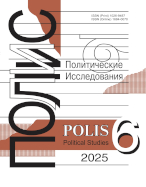Effectiveness of public investment:
a «Model-to-evaluation» strategy
Akhremenko A.S.,
Dr. Sci. (Polit. Sci.), Professor, Senior Researcher, Laboratory for political and psychological research, HSE University, Moscow, Russia, aakhremenko@hse.ru
elibrary_id: 124097 | ORCID: 0000-0001-8002-7307 | RESEARCHER_ID: L-3000-2015
DOI: 10.17976/jpps/2014.06.02
Akhremenko A.S. Effectiveness of public investment: a «Model-to-evaluation» strategy. – Polis. Political Studies. 2014. No. 6. https://doi.org/10.17976/jpps/2014.06.02
The study has two major focuses. The first one is of a methodological kind: we investigate the capabilities of a formal dynamic model to link theory and empirical estimation techniques. The other one is much more specified: we deal with the problems of public good provision and public capital accumulation and depreciation. Tying it all together, we demonstrate how formal theory can adjust the evaluation of public investment efficiency. The first part of the paper presents the dynamic formal model construction. The core of it is Cobb-Douglas production function with public and private capital as input factors. Public capital stock is increased by budget investment inflow. A set of parameters which regulate system’s efficiency enters the model. They are total factor productivity, public investment effectiveness and the efficiency of public assets’ maintenance and utilization. We also define a special policy space of the model. In the major part of the paper we examine the data, generated by various models with different efficiency parameter values, via Data envelopment analysis (DEA). We demonstrate that the best estimates are obtained when we use cumulative inputs (the sum of budgets investments over a few time periods). Thus we show that dynamic formal model analysis can make a practical contribution to estimation techniques’ “fine tuning”.
See also:
Akhremenko A.S.,
Estimation of the state’s effectiveness in the production of public services: a theoretical model and the methods of measuring. – Polis. Political Studies. 2012. No1
Akhremenko A.S., Petrov A.P.,
Political institutions, efficiency and deprivation: essay of analogue computation. – Polis. Political Studies. 2012. No6
Akayev A.A.,
«A Mathematical Model Should Be Good Help for Politicians…». – Polis. Political Studies. 2009. No3
Miroshnichenko I.V., Morozova E.V., Rusiya N.T.,
Intangible resources of rural development policy: pyramid of opportunities. – Polis. Political Studies. 2025. No1
Pushkaryova G.V.,
Political space: problems of theoretical conceptualization. – Polis. Political Studies. 2012. No2




.jpg)






 print
print
.jpg)
.jpg)